
Word Count: 11456
Included H5P activities: 10
(Note: This resource's metadata has been created automatically by reformatting and/or combining the information that the author initially provided as part of a bulk import process.)


Word Count: 11456
Included H5P activities: 10
(Note: This resource's metadata has been created automatically by reformatting and/or combining the information that the author initially provided as part of a bulk import process.)

This edited volume highlights how institutions, programs, and less commonly taught language (LCTL) instructors can collaborate and think across institutional boundaries, bringing together voices representing different approaches to LCTL sharing to highlight affordances and challenges across institutions in this collection of essays. Sharing Less Commonly Taught Languages in Higher Education showcases how innovation and reform can make LCTL programs and courses more attractive to students whose interests and needs might be overlooked in traditional language programs. The volume focuses on how institutions, programs, and LCTL instructors can work together, collaborating and thinking across institutional boundaries to explore innovative solutions for offering a wider range of languages and levels.
With challenges including instructor isolation, difficulty in offering advanced courses or sustaining course sequences, and minimal availability of pedagogical materials compared to commonly taught languages to overcome, this collection is a vital resource for language educators and language program administrators.
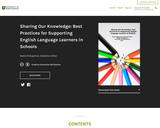
To complete the course ECUR 415.3: Current Issues in EAL, students are required to submit a final paper that reflects their growing knowledge about English as an Additional Language (EAL). EAL is the term used in Saskatchewan to describe students who speak languages other than English and require adequate levels of English to be successful with the school curriculum.
Most students enrolled in the online course ECUR 415 are practicing teachers who are working toward a Post-Degree Certificate in EAL Education (PDCEAL), while continuing to live and work in various locations both within and outside of the province. The certificate program, offered through the College of Education, University of Saskatchewan, is recognized by provincial education authorities as being equivalent to one full year of post-degree study. As such, the certificate equips teachers with the knowledge and expertise to be considered teacher-specialists of EAL Education. The course ECUR 415 also attracts some pre-service teachers who are pursuing a Bachelor of Education degree and have an interest in EAL Education.
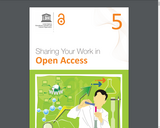
This is the last Module of the course on Open Access for researchers. So far you have studied about Open Access, its history, advantages, initiatives, copyrights and licensing, evaluation matrix for research – all in the context of scholarly communication. In this Module with just two units, we would like to help you share your work in Open Access though repositories and journals. At the end of this module, you are expected to be able to:
- Understand the publication process involved in dissemination of scholarly works;
- Choose appropriate Open Access journals and repositories for sharing research results;
- Use social media to promote personal research work and build reputation.
In Unit 1, we discuss the research publication process at five stages – planning stage, preparing stage, pre-publication stage, publication stage and postpublication stage. We emphasize the importance of social media in sharing and making your work visible to the target groups.
In Unit 2, we focus on sharing your research through OA repositories and Journals. First we discussed the different types of repositories to select and highlighted the steps that you may consider including deposit in your own institutional repositories or in global open repositories. We then discuss the sources of finding and deciding on OA journals. This unit also provides guidance on choosing the right OA journals, as the quality of OA journals is often questioned.
This is Module Five of the UNESCO's Open Access Curriculum for Researchers.
Full-Text is available at http://unesdoc.unesco.org/images/0023/002322/232211E.pdf
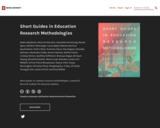
Short Description:
Short guides in common research methodologies, created by doctoral students for doctoral students.
Word Count: 29950
(Note: This resource's metadata has been created automatically by reformatting and/or combining the information that the author initially provided as part of a bulk import process.)

Word Count: 30922
(Note: This resource's metadata has been created automatically by reformatting and/or combining the information that the author initially provided as part of a bulk import process.)

2020-2021 Edition
Word Count: 7204
(Note: This resource's metadata has been created automatically as part of a bulk import process by reformatting and/or combining the information that the author initially provided. As a result, there may be errors in formatting.)

Social Emotional Learning is considered the most important topic in Education.

Lesson plans for the junior-intermediate classroom
Word Count: 79522
(Note: This resource's metadata has been created automatically by reformatting and/or combining the information that the author initially provided as part of a bulk import process.)

Long Description:
Sociology of Education in Canada utilizes a contemporary theoretical focus to analyze how education in Canada is affected by pre-existing and persistent inequalities among members of society. It presents the historical and cultural factors that have shaped our current education system, examines the larger social trends that have contributed to present problems, discusses the various interest groups involved, and analyzes the larger social discourses that influence any discussion of these issues.
To achieve this, Karen L. Robson uses many current, topical, and relatable issues in Canadian education to ensure that students fully comprehend the information being presented and leave with an appreciation of how the sociology of education is inextricably linked to issues of stratification.
Word Count: 143501
(Note: This resource's metadata has been created automatically by reformatting and/or combining the information that the author initially provided as part of a bulk import process.)

Short Description:
This supplementary first-year physics textbook explores the role of language, alongside figures and mathematical symbols, in solving physics problems. The aim of this textbook is to help students gain extended, practical awareness of the roles of language in solutions to a range of first-year physics problems. The learning is guided mainly by comparing how language is used in formal, written solutions and in students' problem-solving dialogues. With new awareness how and why language is used in these two central forms of university physics practice, students can more effectively communicate solutions and guide their development as physicists and users of scientific English. After introducing problem-solving strategies and foundational aspects of language, the textbook guides students in the three primary functions of language in solutions: to represent concepts and phenomena, organize messages to facilitate their interpretation, and evaluate knowledge claims. Learning is largely task-based, emerging from completing the textbook tasks and reviewing feedback. The textbook is recommended for use alongside first-year physics instruction in self-guided study or instructor-facilitated contexts such as physics tutorials and English for physics courses.
Long Description:
This textbook combines the perspectives of physics and language to help you solve first-year physics problems and communicate your problem-solving choices more consciously and effectively. From the view of physics, the units present physics problems linked to the set of physics concepts typically taught in first year, focusing on how students with various physics competencies solve problems in dialogue and report their solutions in writing. By exploring the various competencies involved in solving physics problems and illustrating these competencies in solutions produced by students with different strengths and weaknesses, this textbook aims to help you understand and develop your own competencies.
A language perspective on learning first-year physics
The perspective of language complements the learning in physics because language systems are a key resource for thinking through and solving physics word problems. Language use in specialized activities such as solving physics problems tends to form identifiable patterns, implying that some language choices are more effective than others. Working through this textbook, you will observe the systems of language choices available for solving physics problems and develop capacities to use language more mindfully and effectively in your physics work.
Physics knowledge is produced, exchanged, and assessed in two main forms in first year courses, in speech and writing. In each textbook unit, a problem is introduced that requires application of one or more focal physics concepts, exploring spoken and written solutions to this problem to help you improve the effectiveness of solutions in both forms. Each unit also focuses on a specific function or sub-function of language, such as how concepts are represented or how solutions are organized, which is explored by comparing the spoken and written modes of communicating physics.
Across the 14 units, the textbook describes and explains the functional scope of the English language in shaping valued physics knowledge. For example, we explore the use of particular functional structures of English that physicists typically use when a problem requires us to re-interpret the concrete, physical world in terms of abstract concepts, such as when modelling a running person (concrete) as a point mass (concept).
The language perspective helps us answer questions such as these: What are the functions of language in solving physics problems? How does language help us to shift perspectives between a problem’s dynamic, physical situation and the stable, theoretical concepts involved? What are the roles of visual figures and mathematical symbolism relative to language in solving physics problems? What language choices are involved in effectively solving a physics problem in group dialogue and writing? Can we distinguish between reporting and explaining our solution? If so, how? What does it mean for a solution to be effectively communicated?
The knowledge and experiences you build in this course about the role of language in physics will help you to meet your expectations for solving physics problems and those of your peers and instructors. This aim is achieved in combination with the increased awareness and development of your competencies in solving physics problems. The guiding aim of this textbook is for you to apply the knowledge and experiences you gain towards your personal and professional development according to your interests in physics and science.
The organization of the textbook
The roles of language in solving physics problems are explored in increasing detail across the textbook units. Unit 1 provides the foundational perspectives on physics and language. The focus for learning is on strategies for solving word problems and the units and scales of language use in communicating the solutions.
Units 2 to 14 focus on physics concepts typically covered in first year, from motion along a straight line to fluid dynamics. Each unit introduces a problem developed to apply the unit’s focal concept and explores with you the solutions to these in spoken and written forms. A second problem is then introduced in the unit as an opportunity to apply, assess, and reflect on what you’ve learned.
Ways to use the textbook
The focus of this textbook is on improving your use of language, problem-solving strategies, and physics concepts in solving problems. As such, this book is not intended to replace a physics first-year textbook. Rather, this textbook is designed to be used in combination with a standard first-year physics textbook or course, where the methods and concepts are covered in detail.
This textbook is designed for first-year Science or Applied Science programs, where it would be used in (1) the tutorial section of the physics course focusing on problem-solving competencies and communicating solutions or in (2) a linked content-and-language syllabus such as an English for First-Year Physics course. This textbook will also find good use in (3) advanced placement high-school science programs, (4) pre-sessional university preparation programs, and (5) refresher courses for first-year physics. The book was designed especially for multilingual students of physics; however, it is expected to interest any physics enthusiasts with an interest in explicit understanding and extended practice of the language of physics.
The course is designed to be used in self-guided learning, peer study groups, or instructor-led classes. Whatever approach you take, learning through this textbook happens through your active engagement with the tasks. The task-based design involves a cycle of pre-task preparation, task activity, and post-task checking of responses and reflection. The post-task checking of your responses is crucial as this is typically where the effectiveness of your task performance is explained, that is, where the teaching emerges in dialogue with your input.
This course also includes optional features for deeper engagement and community-building around the language of solving physics problems. Chief among these features is the sharing of physics problems and solutions produced by you, the textbook users. As a user of the online textbook, you are invited to submit your solutions to the collection and compare these in terms of language features against our analyses of how language is used across all submissions. Users are also encouraged to design and share unique problems that reflect their particular interests and curiosities within and beyond physics. As the collection grows, so will the analyses, opportunities for engagement, and the learning community.
Word Count: 6443
(Note: This resource's metadata has been created automatically by reformatting and/or combining the information that the author initially provided as part of a bulk import process.)

This textbook provides information on the practice of teaching special education in the secondary schools. Research-based practices are explained for supporting student functioning in language arts, math, and other content areas. Specifically, the eight chapters address: (1) Introduction to secondary special education; (2) Curriculum-based measures to inform learning; (3) Strategies for working in a co-teaching environment; (4) Strategies for improving student behavior; (5) Strategies to support post-secondary transition; (6) Strategies for improving student outcomes in reading; (7) Strategies improving student outcomes in writing; and (8) Strategies for improving student outcomes in math.

Knowledge and Learning in the Digital Age
Word Count: 11862
(Note: This resource's metadata has been created automatically by reformatting and/or combining the information that the author initially provided as part of a bulk import process.)

Spring 2023
Word Count: 27556
Included H5P activities: 4
(Note: This resource's metadata has been created automatically by reformatting and/or combining the information that the author initially provided as part of a bulk import process.)

Short Description:
This is a collection of blog posts created by the St. Clair Tutor Team of St. Clair College for OntarioExtend's 9x9x25 Challenge in the Fall of 2018 on the topics of teaching, learning and tutoring. Each blog contributor is a full-time student and a peer tutor. In addition to the blog posts, this guide includes discussion questions, a scenario and a reflection prompt suitable as part of a meeting or training session with tutors in a post-secondary setting.
Word Count: 7786
(Note: This resource's metadata has been created automatically by reformatting and/or combining the information that the author initially provided as part of a bulk import process.)
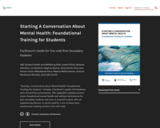
Facilitator’s Guide for Use with Post-Secondary Students
Short Description:
"Starting a Conversation about Mental Health: Foundational Training for Students" includes a facilitator’s guide with handouts and a PowerPoint presentation. This adaptable training resource covers foundational mental health and wellness information for post-secondary students and ways to respond to peers who are experiencing distress. It can be used for a two-to three-hour synchronous training session or for self-study.
Long Description:
Starting a Conversation about Mental Health: Foundational Training for Students includes a facilitator’s guide with handouts and a PowerPoint presentation. This adaptable resource covers foundational mental health and wellness information for post-secondary students and ways to respond to peers who are experiencing distress. It can be used for a two-to three-hour synchronous training session or for self-study. This resource has a decolonized perspective and was guided by the following principles: accessible, adaptable, culturally located, evidence-informed, inclusive, and trauma-informed. Handouts include a wellness wheel self-assessment tool, information on coping strategies, mental health resources, and scenarios and responses written by post-secondary students.
Word Count: 33363
(Note: This resource's metadata has been created automatically by reformatting and/or combining the information that the author initially provided as part of a bulk import process.)

Short Description:
"Starting a Conversation About Suicide: Foundational Training for Students" includes a facilitator’s guide with handouts and a PowerPoint presentation. This adaptable resource offers sensitive, respectful, and detailed training on suicide awareness and response. It can be used for a two- to three-hour synchronous session, and it can be offered by counsellors and other trained staff to post-secondary students interested in creating safe and supportive environments on their campuses.
Long Description:
Starting a Conversation About Suicide: Foundational Training for Students includes a facilitator’s guide with handouts and a PowerPoint presentation. This adaptable resource offers sensitive, respectful, and detailed training on suicide awareness and response. It was developed to reduce the stigma around suicide and to help students acquire the skills and confidence to ask if a peer is considering suicide, listen in a non-judgmental way, and refer them to appropriate resources. It can be used for a two- to three-hour synchronous session, and it can be offered by counsellors and other trained staff to post-secondary students interested in creating safe and supportive environments on their campuses. It was created to be accessible, adaptable, culturally located, evidence-informed, inclusive, and trauma-informed.
Word Count: 33760
(Note: This resource's metadata has been created automatically by reformatting and/or combining the information that the author initially provided as part of a bulk import process.)
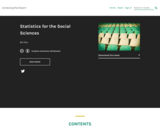
Word Count: 145555
(Note: This resource's metadata has been created automatically by reformatting and/or combining the information that the author initially provided as part of a bulk import process.)

Short Description:
Sticks and Stones was written for budding facilitators and professionals alike. It is intended to provide some ideas and prompt the reader to explore their strengths and create their own activities!
Word Count: 3298
(Note: This resource's metadata has been created automatically by reformatting and/or combining the information that the author initially provided as part of a bulk import process.)

Short Description:
What is the place of sports at a university? Students share what they learned about sports of all kinds on campus. From 'built' & 'natural' environment sports, to esports, recreational activities, intramural, club, and spectator sports, students share stories of how sports influence the college going experiences of campus life. Cover Photo Credit: Dennis Wise/University Photography
Word Count: 21855
(Note: This resource's metadata has been created automatically by reformatting and/or combining the information that the author initially provided as part of a bulk import process.)